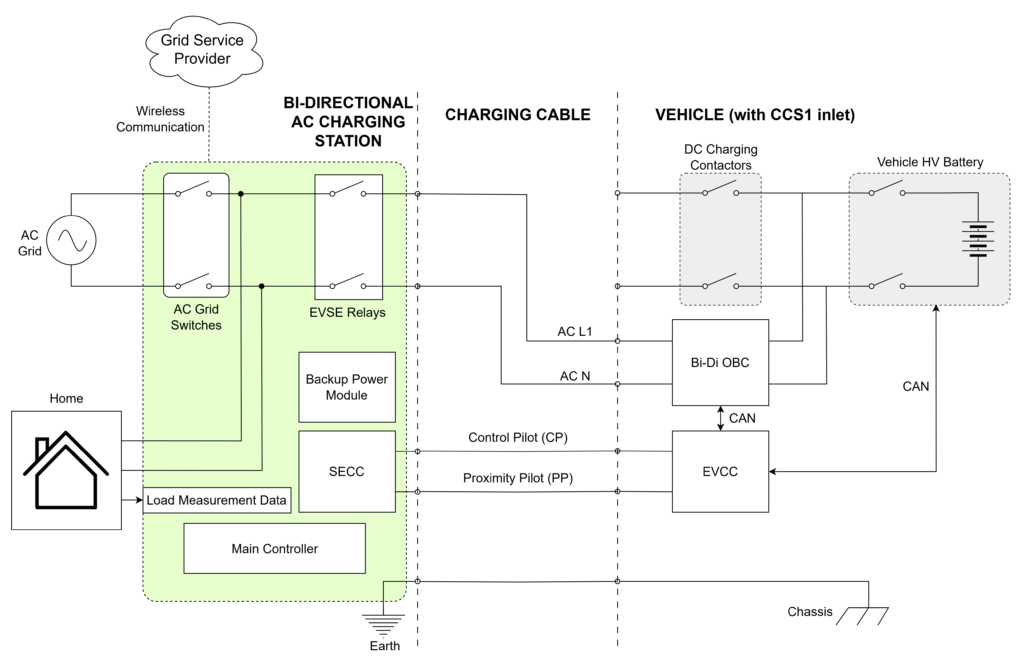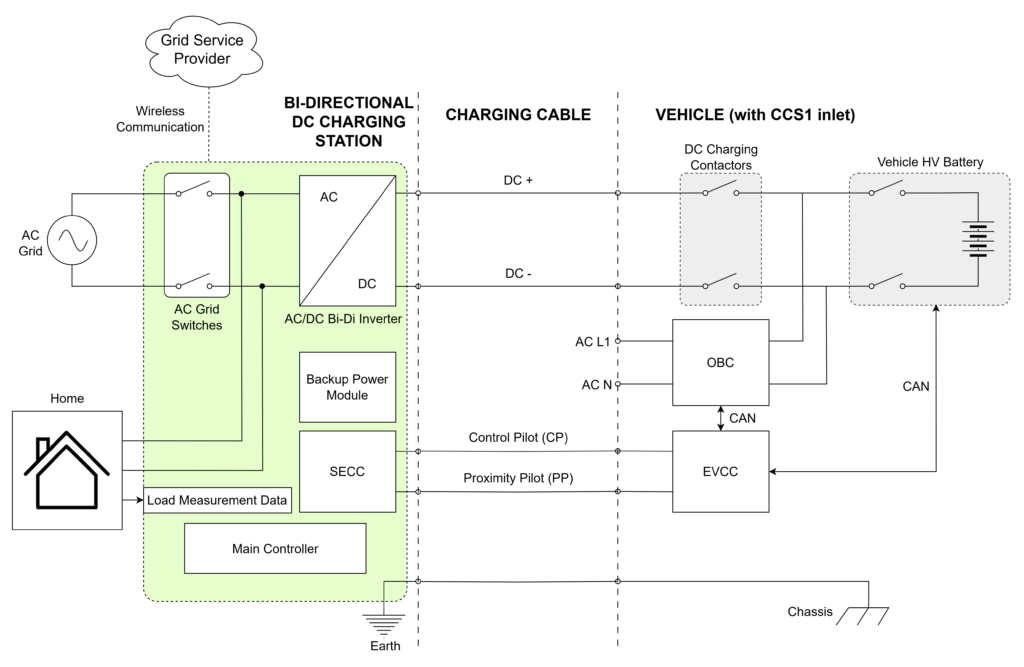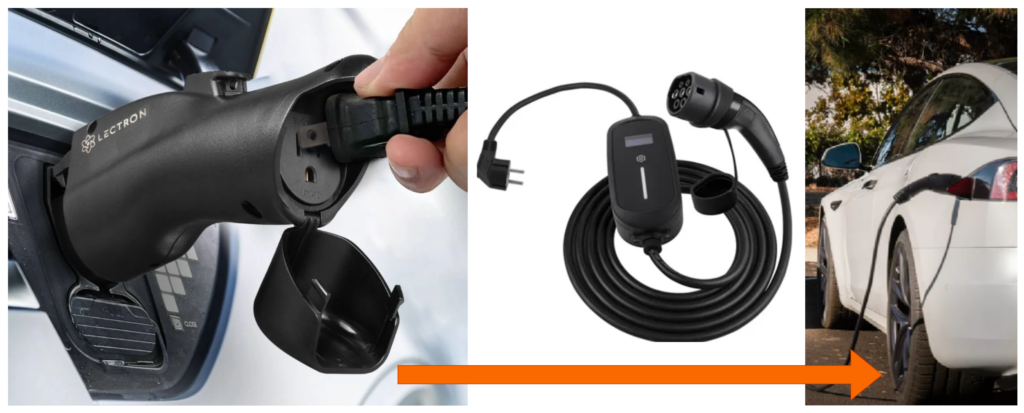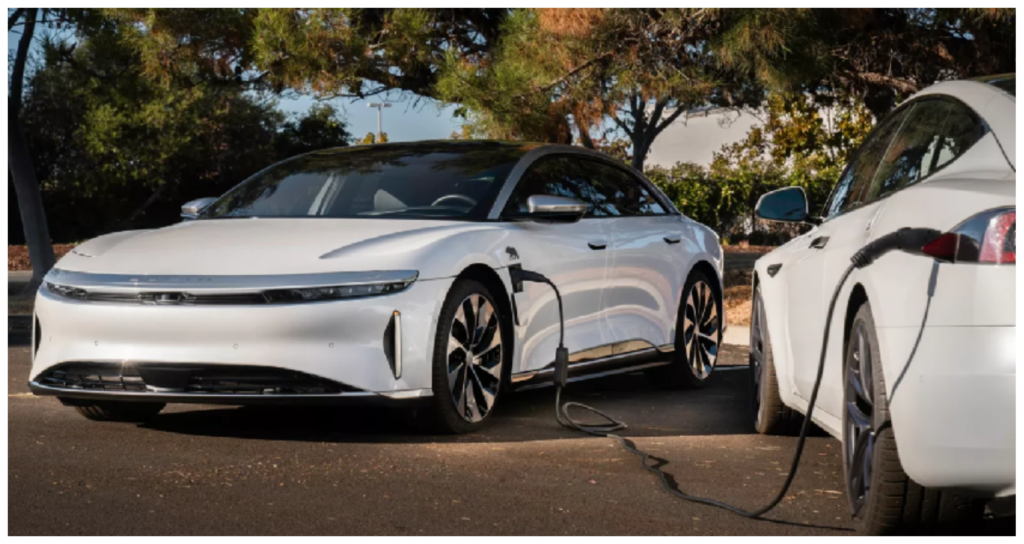Bidirectional Power Transfer (BPT) or Bidirectional Charging in EVs: Overview
Abbreviations:
BPT = Bidirectional Power Transfer
EV = Electric Vehicle
EVSE = Electric Vehicle Supply Equipment (Charging Station)
EVCC = Electric Vehicle Communication Controller
SECC = Supply Equipment Communication Controller
OBC = On-Board Charger
V2G = Vehicle to Grid
V2H = Vehicle to Home
V2B = Vehicle to Building
V2L = Vehicle to Load
V2V = Vehicle to Vehicle
What is Bidirectional Power Transfer (BPT) or Charging in EVs?
Bidirectional power transfer in EVs is a technology that allows energy to flow in two directions: from the power grid to the vehicle (G2V, or grid-to-vehicle) and back from the vehicle to the grid or other loads (V2X, where “X” can represent grid, home, load, etc.). This functionality is made possible by advanced inverters and control systems within the EV and its charging infrastructure. Bidirectional charging enables EVs to act as mobile energy storage systems, providing additional value beyond transportation.
Types of Bidirectional Power Transfer: AC and DC
Bidirectional power transfer in EVs can be categorized into AC and DC systems. Both enable two-way energy flow but differ in how they handle energy conversion and infrastructure requirements.
1. AC Bidirectional Power Transfer
Definition:
Energy exchange between the EV and the grid or external load occurs using AC. The vehicle’s OBC manages the conversion of AC to DC (for charging) and DC to AC (for discharging), as the EV battery stores energy in DC.

Key Features:
- Relies on the vehicle’s Bidirectional OBC for power conversion.
- Typically supports lower power levels than DC systems due to onboard charger limitations.
Applications:
- V2G (Vehicle-to-Grid): Providing energy back to the grid for grid stabilization.
- V2H (Vehicle-to-Home): Supplying power to a home during outages or peak times.
- V2L (Vehicle-to-Load): Powering external devices and appliances.
- V2V (Vehicle-to-Vehicle): Transferring energy between two EVs.
2. DC Bidirectional Power Transfer
Definition:
Energy exchange between the EV and charging station occurs directly in DC form. The DC charging station performs the necessary conversion between AC (grid power) and DC (battery power) for both charging and discharging.

Key Features:
- Eliminates the need for the EV’s Bidirectional onboard charger.
- The charging station’s bidirectional inverter manages the power conversion, enabling higher power levels and faster energy transfer compared to AC systems.
- Requires dedicated DC charging infrastructure, such as Bidirectional DC chargers.
- Suitable for high power applications.
Applications:
- V2G (Vehicle-to-Grid): Providing high-power energy discharge to stabilize the grid.
- V2H (Vehicle-to-Home): Acting as a robust backup power source for homes or buildings.
Understanding the AC and DC Bidirectional Charging Stations
To understand the various BPT modes like V2G, V2H, and others, it’s essential to first understand the fundamental operations of AC and DC charging stations. Below, we outline their key functions and differences, with reference to block diagrams for each system.


Common Functions of AC and DC Charging Stations
Both AC and DC charging stations share several critical functions, regardless of their specific roles in bidirectional power transfer:
- Communication with the Grid Service Provider
- The charging station interfaces with the grid to determine:
- The power requirements (how much power is needed).
- Timing (when power is needed and for how long).
- This ensures efficient grid energy management, especially during peak demand or emergencies.
- The charging station interfaces with the grid to determine:
- Control of AC Grid Switches
- Switches are operated depending on the mode:
- In V2H mode, during a power blackout, the switches remain open to prevent back-feeding energy into the grid, ensuring safety.
- In V2G mode, the switches close, enabling power transfer from the EV to the grid.
- Switches are operated depending on the mode:
- Communication with the EV
- The station exchanges information with the EV using appropriate charging standard protocols (e.g., ISO 15118).
- This includes data on battery status, charging or discharging requests, and operational commands.
- Load Measurement Data
- Stations receive load measurement data from the home or building. This information helps regulate power supplied to the grid or load effectively.
- Backup Power Module
- Includes a backup power supply to support low-voltage (LV) operations within the charging station. This ensures continuous functionality for control units and the operation of AC grid switches, even during power outages.
- Energy Metering
- Equipped with energy meters to measure the energy transferred to and from the EV. This data is essential for billing and usage monitoring purposes.
Key Differences Between AC and DC Charging Stations
- Power Conversion
- DC Charging Station:
- Performs the AC-to-DC conversion during charging and DC-to-AC conversion during discharging.
- The conversion happens inside the station, making it capable of higher power levels and faster charging/discharging.
- AC Charging Station:
- Do not perform power conversion. The EV’s OBC is responsible for converting AC to DC for charging and DC to AC for discharging. (read more about Bidirectional OBC)
- Has only EVSE relays to control the energy flow between the EV and the grid.
- DC Charging Station:
Applications of Bidirectional Charging in EVs
Bidirectional charging unlocks a range of applications that turn electric vehicles (EVs) into dynamic energy assets. Here are the key applications explained in detail:
1. Vehicle-to-Grid (V2G)
What is V2G?
Vehicle-to-Grid (V2G) allows EVs to send stored energy back to the grid when required, helping stabilize the electricity grid and supporting its operations during peak loads. Through V2G, EVs can regulate grid voltage and frequency and reduce grid strain during demand surges.
Which types of BPT support this?
Both AC and DC BPTs support V2G.
Why is it needed?
- Grid Stabilization: Helps maintain grid balance by supplying or absorbing energy.
- Frequency Regulation: Helps maintain stable grid frequency by compensating for energy imbalances.
- Revenue Opportunity: EV owners can earn by participating in energy trading programs and providing ancillary services to grid operators.
How is it done? (refer above System diagrams for details)
- AC Grid Switches remain closed to allow energy flow between the EV and the grid.
- The charging station communicates with the grid service provider to understand energy needs.
- Energy is sent to the grid or received from grid based on grid needs.
- If the home requires energy during this process, it draws directly from the grid.
- The EV’s discharge and charge power limits are respected throughout the process.
Challenges:
- Increased battery degradation due to frequent charging and discharging.
- Requires specialized infrastructure like smart charging stations.
- Regulatory frameworks and standardization need further development.
2. Peak Shaving
What is Peak Shaving?
As the name implies, peak shaving reduces the maximum power drawn by a home or building from the grid during times of high electricity demand. This is achieved by discharging stored energy from EVs to supplement the energy needs locally, thereby lowering reliance on grid power and reducing peak electricity costs. Unlike V2G, the energy is utilized within the home or building instead of being sent back to the grid.
Which types of BPT support this?
Both AC and DC BPTs support Peakshaving.
Why is it needed?
- Cost Savings: Many utilities charge users based on peak power consumption. Peak shaving helps lower electricity bills by reducing demand during peak periods.
- Grid Overload Prevention: Reduces strain on the grid during demand surges.
How is it done? (refer above System diagrams for details)
- AC Grid Switches remain closed for continuous connection to the grid.
- The charging station monitors energy usage in the home through load measurement data.
- Based on the load requirements, required energy is delivered.
- If the home requires more energy than the BPT system can provide, additional power is sourced from the grid.
Challenges:
- Potential reduction in battery lifespan due to frequent cycling.
- Requires sophisticated infrastructure to monitor and manage energy flows.
- Regulatory and technical challenges need to be addressed.
3. Vehicle-to-Home (V2H) or Vehicle-to-Building (V2B)
What is V2H/V2B?
V2H or V2B enables an EV to supply energy directly to a home or building, acting as a backup power source during outages or as part of an integrated energy management system. Often referred to as “Island Mode”, this system isolates the home or building from the grid during operation. Both AC and DC BPTs support this mode.
Which types of BPT support this?
Both AC and DC BPTs support V2H/V2B.
Why is it needed?
- Emergency Backup Power: Provides electricity during power outages.
- Reduced Grid Dependency: Reduces reliance on the grid and enhances energy security.
How is it done? (refer above System diagrams for details)
- The charging station detects grid failure and initiates V2H or V2B.
- It opens the AC grid switches to isolate the home from the grid, preventing energy backfeeding.
- The BPT system discharges energy to provide a stable voltage and frequency, powering home appliances.
- The system ensures energy delivery stays within the EV’s power limits.
Challenges:
- Battery limitations may restrict the duration of power supply.
- Regular use for V2H can accelerate battery degradation.
4. Vehicle-to-Load (V2L)
What is V2L?
Vehicle-to-Load (V2L) allows an EV to power external devices or appliances, such as tools, electronics, or camping equipment, using an onboard charger. It is especially useful for outdoor or emergency scenarios and is primarily supported by AC BPTs. (refer Vehicle to Load (V2L) in EVs for more details)

Which types of BPT support this?
Only AC BPT support V2L.
Why is it needed?
- Portable Power Source: Provides energy for remote or outdoor activities, such as camping.
- Convenience: Simple to use without additional infrastructure.
How is it done?
- An external adapter is connected to the EV’s charging port, converting it into a standard socket.
- The EV detects the adapter and supplies energy at a constant voltage and frequency upon user request.
- The user can then connect, and power external devices or appliances as needed.
Challenges:
- Potential impact on battery lifespan with frequent use.
- Not suitable for powering large-scale or continuous loads.
5. Vehicle-to-Vehicle (V2V)
What is V2V?
Vehicle-to-Vehicle (V2V) allows energy to be transferred directly between two electric vehicles. This enables one EV to share its stored energy with another, offering a practical solution for EVs that require additional charge, especially in remote locations or emergency situations.
Which types of BPT support this?
Only AC BPT supports V2V charging.
Why is it needed?
- Provides a quick and flexible energy solution for EVs in need, especially in areas lacking access to charging infrastructure.
- Serves as a practical method to assist other EVs during emergencies.
- Encourages energy sharing among EV users, enhancing EV usability and convenience in remote or off-grid locations.
How is it done?
Option 1: Using a V2L Adapter and Mode-2 Charger
- A V2L adapter is attached to the Source EV’s charging port to convert the charging inlet into a standard power socket.
- A Mode-2 charger is then connected between the power socket of the Source EV (acting as the energy provider) and the Receiver EV.
- Upon user request, the Source EV provides stable AC power through its onboard charger, and the Receiver EV uses its onboard charger to convert the AC power back to DC for battery storage.
- The energy transfer process is controlled by the Source EV’s onboard system to ensure safe operation and compliance with power limits.

Option 2: Direct Connection Between EVs
- In this method, either the Source EV or an intermediate control unit generates the required control pilot signal as per IEC or SAE or GBT standards to initiate the charging process.
- A compatible charging cable is connected directly between the Source EV and the Receiver EV.
- Upon user request, the Source EV switches to energy supply mode, while the Receiver EV enters charge mode.
- The Source EV mimics the functionality of a standard AC charging station, providing a constant voltage and frequency through its onboard charger.
- The Receiver EV detects the incoming power and begins charging its battery.

Challenges:
- Potential strain on the battery of the supplying vehicle, which could reduce its lifespan.
Why is DC V2V not in Use?
DC V2V charging is theoretically possible but not practical due to several technical and hardware limitations:
- Requirement for a Regulated DC Source: Charging an EV with DC power requires a precisely regulated DC source. However, most EVs are not designed to generate or manage a stable DC output for external use.
- Lack of Suitable Hardware in EVs: Unlike bidirectional OBCs used for AC charging, EVs are generally not equipped with the complex hardware needed to function as a high-power DC source.
- Complexity and Cost: Implementing DC V2V would require significant modifications to the EV’s power systems, such as advanced DC converters and enhanced control mechanisms. This increases design complexity and cost, making it impractical for widespread use.
For these reasons, AC-based V2V, which leverages the existing onboard chargers of EVs, is the preferred and more practical approach for energy transfer between vehicles.
In conclusion, BPT is revolutionizing the role of EVs by transforming them into versatile energy assets. From supporting the grid with V2G to powering homes with V2H and enabling portable energy through V2L, BPT technologies open new possibilities for energy efficiency, resilience, and sustainability. While AC-based BPT remains more commonly implemented due to its compatibility and simplicity, DC-based systems play a crucial role in high-power applications. Despite challenges such as battery wear, infrastructure requirements, and regulatory complexities, the benefits of BPT—ranging from cost savings to enhanced energy reliability—make it a promising cornerstone of the evolving energy ecosystem.
EV Charging Explained – Everything you need to know about Electric Vehicle Charging